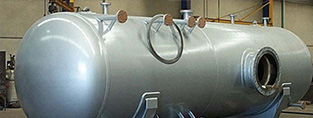
- (03) 5909 8218
- enquiry@fusionweld.com.au
What are the Components of Above Ground and Underground LPG Storage Vessels?
September 10, 2015

Liquid petroleum gas is a global staple, a fuel that feeds rural homes and industrial complexes alike. Kept under pressure or cooled until the flammable gas becomes liquefied, the energy source is contained in special storage vessels to mitigate the dangerous properties of the popular hydrocarbon. It's only when called upon by a gas boiler or another fuel-dependent appliance that the liquid is piped into a building, and it's only through the installation of above ground and subsurface storage vessels that these LPG burners can access the piped energy source.
Regulatory frameworks and engineering companies devote huge resources towards the practice of installing and testing these holding units. The above ground models, in particular, can be seen dotting the landscape as groups of capped cylinders when you skirt an industrial facility. But pay attention to remote rural properties, to farms and lone cottages, as lone LPG vessels placed on concrete plinths are often installed in back yards. This practice keeps the vessels out of sight and places the pipes in easy reach of a boiler or kitchen. Besides these pipes and conduits, the actual vessel takes the form of a cylinder with a pair of end caps, a profiled geometrical shape that has been purposefully selected according to the properties of the butane and propane mix circulating within the vessel. It's a profile that distributes the contained pressure uniformly, thus containing the stored energy medium efficiently.
Underground LPG storage is subject to a slightly different set of rules than the above ground models. For example, weatherproofing affects the coatings and the grading of the steel shell when an above ground metal is selected. Additionally, soil conditions, the acidity or alkalinity of the ground must be accounted for when installing an underground LPG vessel. Supplemental corrosion defeating strategies are also required in the underground installation strategy, meaning cathodic protection nodes are required in the shape of a sacrificial anode.
Since the title of this discussion draws us back to components, your next logical move is to locate these parts and compare them as they relate to above ground and underground LPG vessels. Well, these parts are matched between the two types of vessels, in that they both have inlet valves and safety relief valves. The fill valve is there, as is a float gauge and the vapour release valve. Remember, LPG vessels have an internal vapour space, meaning only 85 percent of the chamber is filled. The real difference comes from the positioning of these components. An above ground model places the parts in logical positions, putting the fill valve and withdrawal port on opposite ends of the tank, for example. Meanwhile, the subsurface unit benefits from placing these key valves and fixtures in a central position, thus keeping maintenance practices simplified should an engineer need to gain access to the vessel's key supplementary parts.
Contact Details
Fusion - Weld Engineering Pty Ltd
ABN 98 068 987619
1865 Frankston Flinders Road,
Hastings, VIC 3915
Ph: (03) 5909 8218
Optimized by NetwizardSEO.com.au
Recent Posts
- Compressed Hydrogen Storage Vessels: Material Selection, Design & Australian Standards
- Welding QA/QC in Oil & Gas Pressure Vessel Fabrication – Ensuring Code Compliance
- AS1210 vs ASME VIII Pressure Vessel Code: Key Differences for Australian Projects
- Mitigating Hydrogen-Induced Cracking in Pressure Vessels: Engineering and Material Strategies
- Storage Tank Solutions Australia: Field-Erected, Prefabricated & Self-Bunded Explained
- Reducing Environmental Risks: Self-Bunded Tanks in Australian Oil & Gas Operations
- Precision in Production: How Pressure Vessels Are Manufactured for Industrial Safety
- Shell & Tube Heat Exchangers: Improve Thermal Control & Energy Recovery in Petrochemical & Pharmaceutical Plants
- In-Service Inspection for Compressed Air Receivers for Power Plant Shutdown Prevention
- Power Plant Pipe Spooling Fabrication – Get Rapid, Code-Compliant Spools Ready for Installation
- Field Erected Tanks: Safe, Reliable On-Site Fuel Storage Solutions in Australia
- Custom Pressure Vessel Fabrication for Flammable Gases
Posts 2025
- Compressed Hydrogen Storage Vessels: Material Selection, Design & Australian Standards
- Welding QA/QC in Oil & Gas Pressure Vessel Fabrication – Ensuring Code Compliance
- View all articles…
Posts 2024
- Large Process Vessels: Optimising the Design for Maximum Efficiency [2025]
- Pressure Equipment Management System Installation: Detect Equipment Faults Early
- View all articles…
Posts 2023
- Pressure Piping System Inspection: A Gift of Safety for the Holidays
- Deaerator Inspections by Fusion-Weld Engineering and How They Reduce System Downtime
- View all articles…
Posts 2022
- How Fusion Weld Keeps Up With AS-NZS ISO 9001:2008 Standard
- Boiler Equipment Safety Inspection During the Summer Season
- View all articles…
Posts 2021
- Avoid These Factors and Practices that Contribute to Sealing Damage in Pressure Vessels
- Do's And Don'ts Of Industrial Boiler Inspection And Maintenance From Fusion-Weld
- View all articles…
Posts 2020
- What are the Risks and Hazards Involved in Pressure Vessel Equipment?
- How to Know if Your Pressure Equipment Needs Repair or Replacement?
- View all articles…
Posts 2019
- Factors that Contribute to Pressure Vessel Failure
- Pressure Vessel Regulations in Australia: What are the Mandatory Requirements?
- View all articles…
Posts 2018
- Pros and Cons of Spherical vs. Cylindrical Pressure Vessels
- What are the Different Hazard Levels in Pressure Vessels?
- View all articles…
Posts 2017
- Transportable Pressure Vessels: The Importance of Inspection and Safety Checks
- Fracture Mechanics and Stress Analysis of Cracks in Pressure Vessels
- View all articles…
Posts 2016
Posts 2015
- What Are Deaerators & Feedwater Vessels?
- Precautions and Safety for Compressed Air Receiver Vessels
- View all articles…
Posts 2014
- Demonstrating In-process Inspection Procedures
- Static Grounding Practices and Standards
- View all articles…